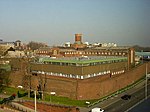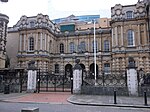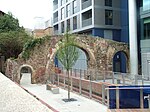Anne Beauchamp, 15th Countess of Warwick
1444 births1449 deaths15th-century English nobility15th-century English womenBarons Burghersh ... and 9 more
Beauchamp familyBurials at Reading AbbeyDaughters of English dukesEarls of Warwick (1088 creation)English countessesHereditary women peersPeople from CardiffPeople from South Oxfordshire DistrictRoyalty and nobility who died as children

Anne Beauchamp, 15th Countess of Warwick (14 February 1444 – 3 June 1449), was the only child and heiress of the English nobleman Henry Beauchamp, 1st Duke of Warwick. She died a child aged 5, after which the earldom of Warwick was inherited by her paternal aunt. The title then passed by marriage to Anne's maternal uncle, Richard Neville, the famous 'Kingmaker' of the later Wars of the Roses.
Excerpt from the Wikipedia article Anne Beauchamp, 15th Countess of Warwick (License: CC BY-SA 3.0, Authors, Images).Anne Beauchamp, 15th Countess of Warwick
Oscar Wilde Memorial Walk, Reading Newtown
Geographical coordinates (GPS) Address Website Nearby Places Show on map
Geographical coordinates (GPS)
| Latitude | Longitude |
|---|---|
| N 51.456347222222 ° | E -0.96508611111111 ° |
Address
Abbey Ruins
Oscar Wilde Memorial Walk
RG1 3JA Reading, Newtown
England, United Kingdom
Open on Google Maps










